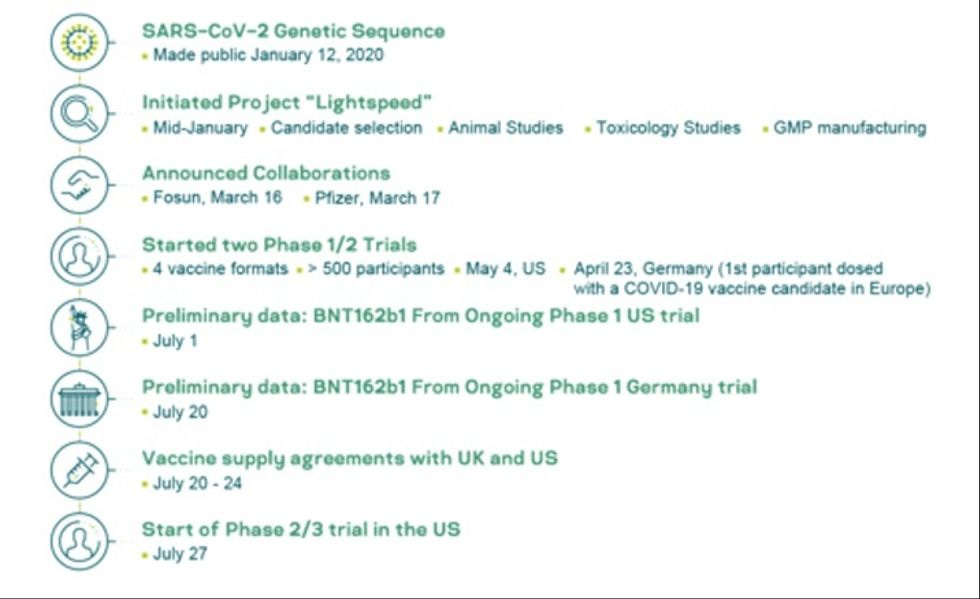Wonksplainer: Whar Corona Vaccine? – The Sequel!
We feel like that's pretty self-explanatory.
Well, well, well little droogies! It's your prodigal pendejo done returned once more, to lay down science at your door. Imagine that last sentence with some beatboxing and it's much cooler that way. At least, in my head.
Now, when last we spoke ( right here, back in March ), I was pretty pessimistic about the chance we'd EVER have a COVID-19 vaccine, let alone anytime soon. Of course, the semi-sentient slime mold currently occupying 1600 Pennsylvania thinks we'll have one faster than Joey Chestnut can slurp down fifty glizzys, but that just ain't gonna happen this year. I'll break it down for you as to why in a momentito, but first I want to give you some hopeful thoughts.
Why did I go from Debbie Downer to Pollyanna on the vaccine? Data baby. Data. I'm excited about two specific vaccines. One is from Moderna, a biotech down the road from Casa de Sagan in Cambridge. The other one keeps being referred to as the Pfizer vaccine, which is technically true, but only because they bought the innovative little company that came up with it, BioNTech, a biotech nowhere near Casa de Sagan, over in Germany.
There are a gazillion other vaccines in development, but these two are furthest along, now in their final phase III studies, with both scheduled to complete this year. Ah, but it's not because they are furthest along that has me thinking happy thoughts. I mean, they have gone from idea to phase III wicked fast, which is swell, but it's the data so far, coupled with their innovative approach that has me happier than Donald Trump in a bathtub full of Russian hooker pee.
Oh, so what's so innovative? I'm glad you asked, cabrones! There are in depth explainers on how vaccines work, including a short one in my last article referenced up top. But, for you busy folks that can't be bothered to click on a link, let's do the super dooper quick version.

Viruses are made up of mostly proteins, and either DNA or RNA, with a few other tidbits as well. Up until the Moderna and BioNTech vaccines, science peeps would inject you with some protein or proteins, artificially grown in yeast or eggs or some other suitable media, that are identical to the virus they are trying to prevent from infecting you. Your body's immune system is slow the first time, but takes out the little proteins that it detects as being not native to you. Kinda like ICE, but in the vaccine case, for an actual good and healthy reason. Then, if you get infected with the virus you were vaccinated against, your immune system has a memory, recognizes the protein faster this time and mounts an attack faster than Joey Chestnut can slurp… well you know, FAST!
Those type of vaccines can work pretty well for viruses that don't mutate their proteins often. However, most corona viruses are fickle little things, and change their proteins like Trump goes through Cabinet members. Here's where the cool science comes in. These days, we can genome sequence critters in days. We isolated corona viruses that cause COVID-19 and had their sequence in the first few weeks of the pandemic. Moderna and BioNTech then made various little synthetic bits of RNA that were identical to sections of the virus. Next up, they did in vitro experiments (think test tubes) followed by in vivo ones (think animals) to test the various bits to see which ones were more likely to elicit immune responses.
And that, muchachos and muchachas, takes us into the clinic where they took their most promising candidates. Traditionally, for vaccine trials phase I is for safety (but also to get a peek at immune response), phase II for a smallish study looking to see that the immune response is strong (and for more safety) and to pick the dose for the big phase III study (30,000 subjects in the BioNTech one!). Phase III is where you compare the rate of infection in vaccinated subjects versus ones that got a placebo vaccine. If the results are killer (in a good way!), then you file your data with the FDA in US (and sister agencies in other countries) and after they give it a proper review, you hopefully get an approval. Here's the timeline for the BioNTech vaccine:

Okay, but the data, the data. This vaccine shows neutralizing antibody levels almost three times greater than those seen in people that have actually contracted COVID-19. The key word in that last sentence is "neutralizing." All antibodies that match up to a virus will bind, but only neutralizing antibodies will actually fuck up the virus by binding in a key spot, or so overwhelmingly that the virus can't do its dirty work. Even better, the vaccine has shown high levels of T-cell (aka "killer cells") activation for a very nice, one-two punch in the virus's dick. Have you ever seen a virus dick? Very small.
Here's their press release with more deets.
Now, the Moderna vaccine uses the same approach, but the data I've seen so far isn't as impressive (no T-cell activation, and some worrisome adverse effects at the higher doses) so, my hopes are on the Germans.
Let's talk timeline now. I will give credit where credit is due and the Trump administration DID give bunches of money to companies with the most promising vaccines to ramp up manufacturing ahead of an approval, in case their vaccine works. This is something we typically do anyway in my industry, but the extra funds may translate to much larger amounts of vaccines (hundreds of millions of doses versus tens of millions) available much sooner.
That still doesn't mean this year, even though Trumpo and the vaccine manufacturers are saying it's possible. Best case, and we're talking stars aligning level best case, is the phase III finishes end of next month. That just means the study is done and the main data is available to show the world. There is still a shiiiiiitload of data to compile, check for accuracy and pull together. Six weeks is the fastest I've seen from end of study to releasing the data, but let's say they manage it in four. That's for 30,000 patients worth of data, about as big as clinical studies get. Theeeeeen, Pfizer (and it will be Pfizer) has to pull all the information together into the giant file that gets sent to the FDA to review. For a lot of the information, that's been pulled together while the phase III has been going (manufacturing info, data from the animal studies, the phase I…) but even so it's going to take them at least two months to send to the FDA for their review. Places I've worked at averaged 3 months for a small file to 6 months for a big one. So, if they manage it crazy fast, that's end of the year and it's just in the hands of the FDA to review and make a decision. Typically, the fastest the FDA will make a decision is six months, but they could probably pull it off in three. So, my guess is that if the Pfizer/BioNTech vaccine works, it could be available for us to get the shot as early as March of next year, but more likely in the summer.
Summer 2021 could have an actual caring human in the White House, a bunch of the current crooks in prison and all of us (who believe in science) protected from COVID-19! Hey, a pendejo can dream.
It was grand to be back again! Follow me on Twitter or email me if you like!
Do your Amazon shopping through this link, because reasons .



Muchas gracias como siempre, Carlos.
glizzy is slang for glock, as in a glock pistol. hot dogs are the same length as an extended clip that goes in a glock pistol, so somehow they're now called glizzies. our language is weird